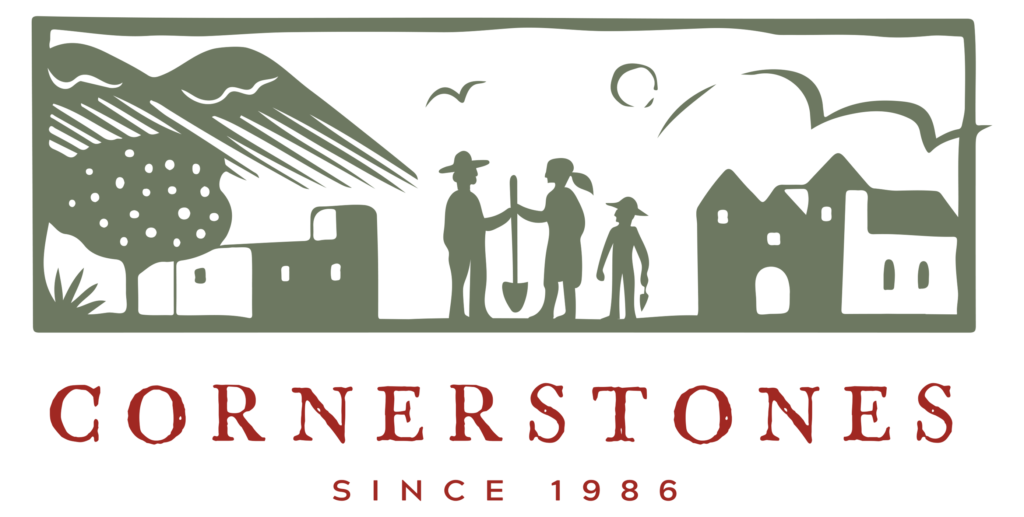Happy New Year!
When I launched this column a year ago, it was an opportunity to look back through the history of Cornerstones and give you a moment to learn or reminisce as I read up on the organization. This year, I am broadening the scope of my column to provide more information about what we are doing today. I will continue to publish columns about our history - there are still a lot of fascinating stories to share - but I want to highlight some of the new initiatives that the Cornerstones team is working on now.
One of the pillars of Cornerstones' mission is supporting individuals and communities continuing the architectural traditions of the Southwest. Educational and professional development opportunities are among the ways that we do this. Right now, with funding from the Getty Foundation and the Chamiza Foundation, we are providing scholarships to Terra 2022, the 13th World Congress on Earthen Architectural Heritage, the largest international gathering of earthen building practitioners and professionals. I was delighted that the Getty Conservation Institute approached us last year to partner with them on this scholarship.
The scholarship is for professionals and students from the 19 Native American pueblos and tribes in New Mexico, tribes and pueblos from Southwestern states and Northern Mexico, to attend the Terra. It is important not only that those communities are included in further skill-sharing around earthen architectural practices, but also that their knowledge, experience, and traditions are highlighted to other parts of the professional community.
Terra 2022 will take place in Santa Fe, New Mexico, June 7-10, 2022, as a hybrid event with both in-person and virtual options. Hundreds of specialists in the fields of conservation, anthropology, archaeology, architecture and engineering, scientific research, site management, and sustainable development of earthen architectural heritage will attend. Workshops, presentations, posters, and digital media will illuminate current research and teach best practices in conserving earthen heritage across the world. Up to 600 attendants are expected to participate either in-person or virtually.
We are accepting applications now. The scholarship will substantially or fully cover attendance, accommodation, and travel costs to Santa Fe to attend Terra 2022.
The full scholarship application and more information is available here: https://www.cstones.org/terra-2022 If you know someone who might want to apply, please forward this email to them or share this link.
Completing Work at Keys Ranch, History-Filled Vista of Joshua Tree
From top left to bottom right: a view of the schoolhouse; the guest house; interior of the schoolhouse; and a picture of our volunteers and NPS staff.
Keys Ranch is an iconic site within Joshua Tree National Park that was added to the National Register of Historic Places in 1975. It is an extensive complex of buildings that demonstrate the tenacity and trials faced by ranchers in California around the turn of the twentieth century. Bill Keys and his family built the small structures between 1910, when the Keys settled there, and 1969, the year of Bill Key's death. The complex includes a ranch house, schoolhouse, store, workshop, guest house, and ten other buildings, all viewable on tours through the Park Service. Stories of Bill Keys and the domestic vista he left behind stand to remind us of another moment in American history, times filled with more toil and isolation as well as cattle rustlers, Western-style shootouts, and the bounties and pains of early-industrial homesteading.
Joshua Tree as a larger area that surrounded the original ranch was declared a national monument in 1936; and Joshua Tree was redesignated as a national park in 1994 when Congress passed the California Desert Protection Act. As a preservation study for the Park Service reported, it was "in the fall of 1964, at the age of 85, Keys sold his ranch, by then a total of 240 acres, to Henry E. Tubman of Los Angeles for a sum reportedly in excess of $131,000. He retained the right of life tenancy on the ranch, and adjoining orchard. At that time, Tubman announced plans to trade this Ranch, within Joshua Tree."
Cornerstones conducted multiple training workshops in historic preservation maintenance at Keys Ranch over the last five years through our partnership with the Desert Southwest Cooperative Ecosystems Studies Unit, the regional chapter of CESU we're part of. Our work stabilized ranch buildings that require maintenance against the harsh conditions of Joshua Tree. "Intense sun/ UV light, strong winds, blowing sand, extreme heat, cold, and humidity/ precipitation ranging from very arid conditions much of the year, to wind-driven rain and humid summer monsoons with torrential rains, and winter snow, take their toll on the old structures at Keys Ranch," wrote our very own Nicholas Holmes who resides in the town of Joshua Tree and took over from Jean Fulton early in the project.
To combat the elements, Nicholas, after Jean, assisted community volunteers, interns, and NPS staff to reconstruct the historic arrastra*, reattach building corners, batten down roofs, jack up walls, reglaze windows, and remove rodents’ access to many of the buildings. Their work will help keep the Keys Ranch standing and open to the public for years to come, a perpetual reminder of part of our national history, how life was in the old wild west, and how quickly times change.
* "The arrastra was a primitive crusher/mill used in old time mining operations. It was horse/mule powered and used the action of grindstones to process the rock extracted from gold mining." That useful definition comes from a USDA exhibit site on Gila National Forest.






